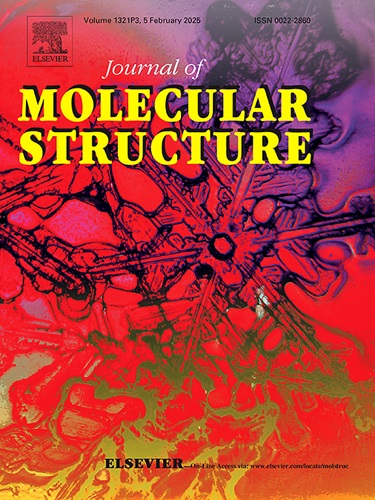One molecule, two switches: Synthesis and DFT studies of Oxalohydrazide-based photoswitches
IF 4
2区 化学
Q2 CHEMISTRY, PHYSICAL
引用次数: 0
Abstract
In organic chemistry, compounds with hydrazone moiety have the potential for application in various fields. Many hydrazone compounds with different functional groups, which can be converted from one state or isomer to another by light or heat, are used as molecular photoswitches. The research on these intriguing functional molecules is rapidly advancing.
Herein, N1, N2-bis(-naphthalen-1-ylmethylene) oxalohydrazide (2) containing the –CO–NH-N=CH– moiety as a photoswitch linker was designed and synthesized. The structures of the synthesized compound were characterized by proton nuclear magnetic resonance (1H NMR), carbon nuclear magnetic resonance (13C NMR), Mass spectrometry (MS), and the Fourier-transform infrared spectroscopy (FT-IR) spectra. Photoswitching of the obtained compound was carried out under UV–light (300–400 nm). As far as we know, this is the first study of photoswitching of oxalohydrazide compounds.
As a result of Ultraviolet-visible spectroscopy (UV–vis), 1H NMR spectra, and density functional theory calculations (DFT), it was found that compound 2 undergoes a characteristic E to Z photoisomerization after light irradiation. Fast E/Z response under UV–light illumination was observed. The thermally unstable Z isomer was found to be recovered to the E isomer by temperature, which refers to T–type photochromic switches. It is envisaged that the compound can be used as a possible photoswitch after further studies are completed.

一个分子,两个开关:草酰肼基光开关的合成和DFT研究
在有机化学中,含腙基团的化合物具有广泛的应用前景。许多具有不同官能团的腙化合物可以通过光或热从一种状态或同分异构体转化为另一种状态,被用作分子光开关。对这些有趣的功能分子的研究正在迅速推进。本文设计并合成了含有- co - nhh -n =CH -基团的N1, n2 -双(-萘-1-基亚甲基)草酰肼(2)作为光开关连接剂。采用质子核磁共振(1H NMR)、碳核磁共振(13C NMR)、质谱(MS)和傅里叶变换红外光谱(FT-IR)对合成的化合物进行了结构表征。所得化合物在紫外光(300-400 nm)下进行光开关。据我们所知,这是第一次对草酰肼类化合物的光开关进行研究。通过紫外可见光谱(UV-vis)、1H NMR谱和密度泛函理论计算(DFT)发现,化合物2在光照射后发生了E到Z的特征性光异构化。在紫外光照射下观察到快速的E/Z响应。热不稳定的Z异构体经温度恢复为E异构体,即t型光致变色开关。预计在进一步研究完成后,该化合物可以用作可能的光开关。
本文章由计算机程序翻译,如有差异,请以英文原文为准。
求助全文
约1分钟内获得全文
求助全文
来源期刊

Journal of Molecular Structure
化学-物理化学
CiteScore
7.10
自引率
15.80%
发文量
2384
审稿时长
45 days
期刊介绍:
The Journal of Molecular Structure is dedicated to the publication of full-length articles and review papers, providing important new structural information on all types of chemical species including:
• Stable and unstable molecules in all types of environments (vapour, molecular beam, liquid, solution, liquid crystal, solid state, matrix-isolated, surface-absorbed etc.)
• Chemical intermediates
• Molecules in excited states
• Biological molecules
• Polymers.
The methods used may include any combination of spectroscopic and non-spectroscopic techniques, for example:
• Infrared spectroscopy (mid, far, near)
• Raman spectroscopy and non-linear Raman methods (CARS, etc.)
• Electronic absorption spectroscopy
• Optical rotatory dispersion and circular dichroism
• Fluorescence and phosphorescence techniques
• Electron spectroscopies (PES, XPS), EXAFS, etc.
• Microwave spectroscopy
• Electron diffraction
• NMR and ESR spectroscopies
• Mössbauer spectroscopy
• X-ray crystallography
• Charge Density Analyses
• Computational Studies (supplementing experimental methods)
We encourage publications combining theoretical and experimental approaches. The structural insights gained by the studies should be correlated with the properties, activity and/ or reactivity of the molecule under investigation and the relevance of this molecule and its implications should be discussed.
 求助内容:
求助内容: 应助结果提醒方式:
应助结果提醒方式:


